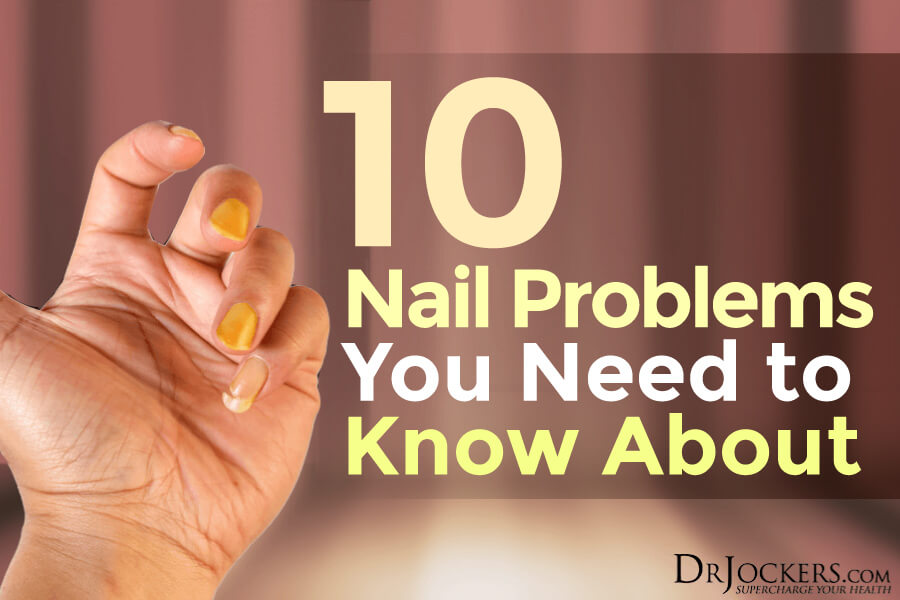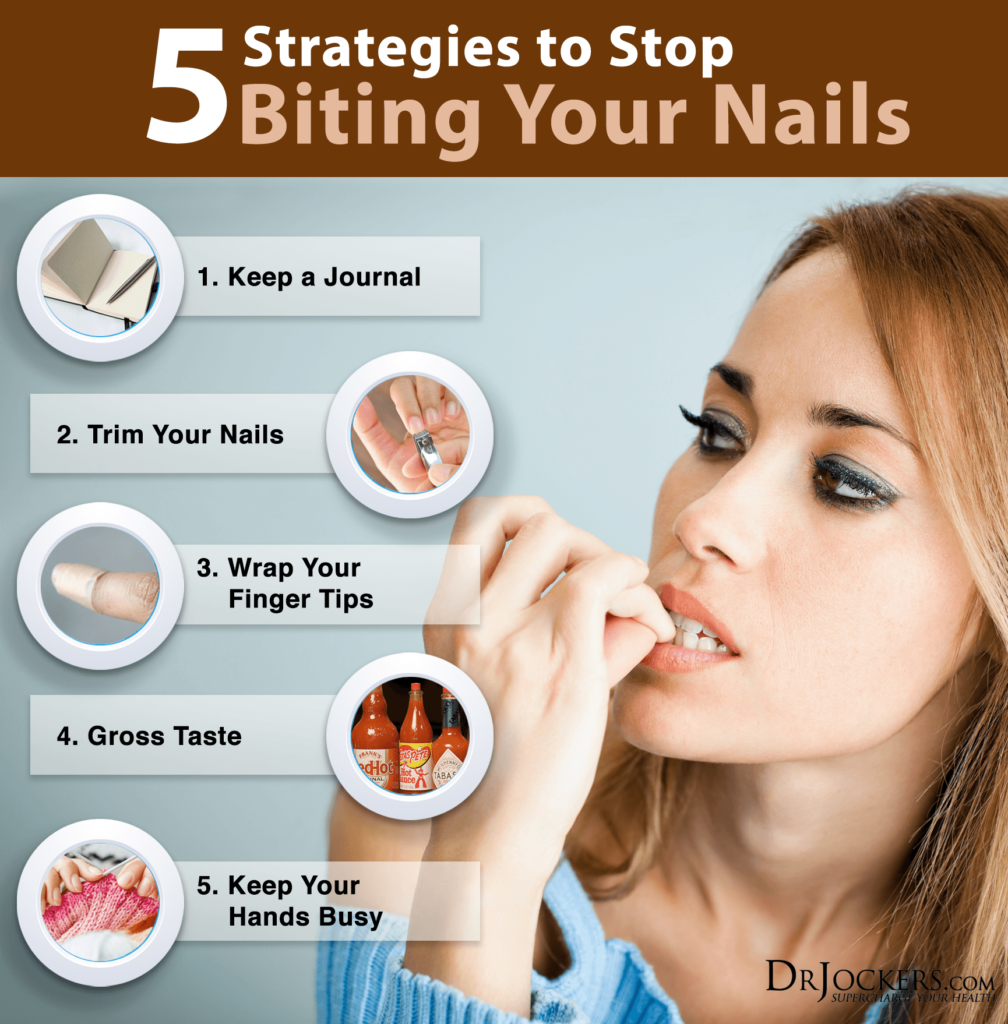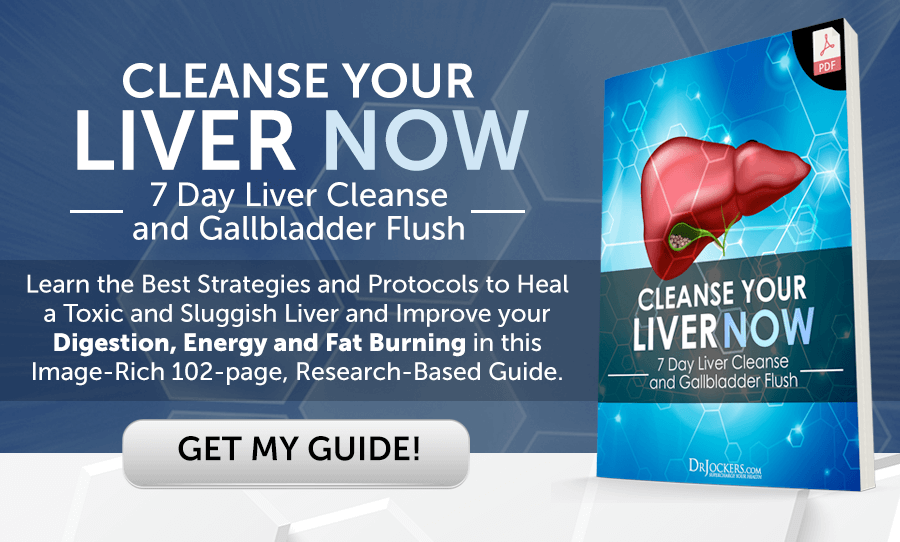10 Nail Problems You Need to Know About
Fingernails and toenails are comprised of a rich complex of micronutrients needed to maintain their health, strength, and shine. A protein structure known as keratin makes up nails along with almost any vitamin and mineral influencing nail health (4). Critical nutrients include iron, zinc, copper, magnesium, sodium, vitamins A, C, and B-complex vitamins like biotin. (8)
The American Academy of Dermatology (AAD) recognizes that nail problems may often be a sign of a serious disease including cancer that should not go untreated. The organization summarizes: (5)
“Nails often reflect our general state of health. Changes in the nail, such as discoloration or thickening, can signal health problems including liver and kidney diseases, heart and lung conditions, anemia, and diabetes.”
The declining health of your nails is your body’s cue that you may have an underlying disease, nutrient deficiency, or chronic health concern. See a dermatologist immediately if you experience any of the following 10 nail problems.

1) Dry, Cracked or Brittle Nails
There are many influences that cause nails to be brittle, dry, and crack easily. Activities that involve your hands in water frequently such as swimming and washing dishes can cause these symptoms. Nails may also be exposed to chemicals from nail polish remover and cleaning products which weakens the nail. If you live in an area with low humidity your nails may also be susceptible to becoming dry and brittle.
Related Conditions: Symptoms of dry, cracked, and brittle nails may be a sign of a fungal infection or a more serious endocrine disorder called hypothyroidism (1).
Nutrient Deficiencies: Associated with a deficiency in vitamins A, C, biotin (B vitamin), and iron (3).
Foods for Improvement: Supplement your diet with foods rich in these nutrients. Vitamins A and C can be found in citrus fruits, berries, and green vegetables. Cruciferous veggies like cauliflower as well as wild caught salmon and carrots are packed with B-complex vitamins like biotin to help maintain strong nails. Turkey, eggs from pastured chickens, and 100% grass-fed beef and lamb are also excellent sources of iron.
Additional Recommendations: One home remedy to treat brittle nails if associated with a fungal infection is to prepare a simple solution of ¼ cup warm coconut oil or olive oil and juice from half a lemon. Soak your nails before bed in this solution for 10 minutes. Wear hand moisturizer gloves overnight for optimal results. (2)
The saturated fat found in the oil moisturizes weak nails and the anti-fungal properties of the coconut oil and lemon break down harmful agents under the nail bed.

2) Yellow Nails
Lifestyle factors such as aging, the use or acrylic nails, constant application of nail polish, and smoking can stain your nails a yellow color. You may seek further options to treat your yellow nails if they also appear thick and crumbly which is often caused by a fungal infection.
Related Conditions: Health problems associated with yellow nails include smoking, fungal infection, diabetes, thyroid disease, psoriasis, and bronchitis (11).
Nutrient Deficiencies: Nutritional deficiencies include antioxidants such as vitamins A and C (12).
Foods for Improvement: Add foods like lemons, limes, berries, and an array of vegetables to your diet. Add grass-fed butter and/or Cod liver oil for vitamin A. If the problem is fungal related, consume 1 or 2 cloves of garlic per day.
Additional Recommendations: If a fungal infection exists, trim the nail down and apply either apple cider vinegar or tea tree oil over the nail bed every 2 hours while you are awake. Rotate what you are using. For instance, apply apple cider vinegar at 8 AM, 12 PM, 4 PM and 8 PM. Use tea tree oil at 6 AM, 10 AM, 2 PM, 6 PM, and 10 PM.
Also, be sure to dry your hands very well each time you rinse your hands. Fungus thrives in environments with extra moisture.

3) White Spots
Most individuals end up with white spots on their nails at some point. Typically white spots are a result of nail trauma resulting in calcium deposits as the body recovers from the damage. If you see white spots, chances are the damage occurred months ago given the length of time it takes for nails to grow.
Other causes of white spots include a fungal infection and gut disturbances which may lead to a deficiency in the critical mineral zinc, which is essential for immune health.
Related Conditions: Fungal infection or possible gastrointestinal disorders that may prevent absorption of adequate nutrients for nail health (13).
Nutrient Deficiencies: Boost the concentration of zinc you are taking into your diet to improve your gut health, and immunity and increase nutrient assimilation by the body.
Foods for Improvement: Foods high in zinc include grass-fed dairy, shellfish, mushrooms, pumpkin seeds, 100% grass-fed beef, spinach, and cashews.
Additional Recommendations: Eradicate the white spots resulting from a fungal infection with a variety of recommendations previously mentioned.

4) Horizontal Ridges
Horizontal ridges that appear as a white line across the nail may also be a result of nail injury. If the ridges appear on multiple nails, there may be a more serious issue resulting from the body’s redirection of responsibilities to heal where there is a more critical need.
For instance, a dermatologist with the Cleveland Clinic, Dr. John Anthony explains that the nail bed pauses its growth during a serious illness such as pneumonia, high fever, or heart attack. Multiple lines represent a chronic issue and you should seek medical attention immediately.
Related Conditions: Pneumonia, high fever, arsenic poisoning, carbon monoxide poisoning, leprosy, psoriasis, circulatory disease, uncontrolled diabetes, malaria, Hodgkin’s disease, and also malnutrition present in individuals with IBS (irritable bowel syndrome), Celiac disease and IBD (inflammatory bowel disease). (14)
Nutrient Deficiencies: What is termed Beau’s lines results from horizontal ridges that appear as indentations into the nail bed and can be associated with a deficiency in zinc (11).
Foods for Improvement: If you have an iron deficiency, then add iron rich foods to your diet as you would do to rid of white spots. Look to add zinc rich foods as well.
Additional Recommendations: The type of horizontal ridges that appear are associated with different subcategories and a possible indication of different systemic diseases. See a doctor immediately to learn what disease the white discoloration of your nails is linked to.

5) Vertical Ridges
Vertical ridges are generally a sign of aging becoming more visible throughout the years as blood circulation in the body decreases. Cases where these ridges are of concern are if you are experiencing nutrient malabsorption also a possible result of reduced circulation and therefore decreased nutrient delivery in younger years. The deeper the ridges, the more severe the deficiency of nutrients.
Related Conditions: Health complications that may cause malabsorption problems in your body include thyroid issues, heavy metal toxicity, rheumatoid arthritis, possible parasitic infection, and digestive disorders. (14)
Nutrient Deficiencies: These may be caused by deficiencies in vitamin B12 and magnesium.
Foods for Improvement: Eat dark leafy greens rich in magnesium and be sure to consume adequate vitamin B12 from meat sources like wild caught salmon, sardines, grass-fed meats, and eggs from pastured chickens.
Ginger is an excellent addition to any diet to improve the assimilation of nutrients past the gut and improve your nails and total health. Add shredded ginger to salads, marinades for meat, and soups, brew in teas, and juice in smoothies.
Additional Recommendations: Ginger is also a superfood in itself with the ability to kill parasites, viruses, and bacteria that cause inflammation of the gut. Consider drinking a cleansing ginger tea daily to prevent infection and optimize your vitamin and mineral levels.

6) Clubbing
Clubbing is characterized by the downward curve at the end of the nail and enlarged fingertips. Clubbed nails are not as common as many the other nail problems and can be present with heart or lung issues resulting from inadequate oxygen flow from the blood to tissue.
Related Conditions: Lung disease, lung cancer and complications such as bronchitis and pneumonia, liver disease, kidney disease, inflammatory bowel disease, congestive heart failure, AIDS, and thyroid cancer can all present with clubbed nails (6, 7, 14).
Nutrient Deficiencies: The most common nutrient deficiency associated with the clubbing of the nails is iodine (4).
Foods for Improvement: Consuming an anti-inflammatory diet to optimize health and boost natural healing processes is essential to managing clubbing nails. To increase your iodine intake, eat some of the most concentrated sources on the planet found in the sea. Sea vegetables like kelp, wakame, and dulse are some of the most iodine rich foods you can eat.
Additional Recommendations: Clubbing is associated with numerous systemic symptoms and although the problem can result from disease, heredity is also to blame.

7) Spoon Nails
Spoon nails curve upwards at the end of the nail resembling a spoon in appearance often flat or dented towards the nail bed at the surface.
Related Conditions: Heart disease, hypothyroidism, autoimmune issues like Lupus, Raynaud’s disease, anemia, and hemochromatosis (excess iron absorption) may be associated with spoon nails.
Nutrient Deficiencies: Iron deficiency is the most common reason for spooned nails but can also result from excessive iron (9).
Foods for Improvement: Foods rich in iron include spinach, pasture raised turkey and chicken, and beans. If you have excessive iron, then using turmeric, green tea, and quercetin supplementation can be very helpful to naturally chelate and pull iron out of the body. In addition, if excess iron is the problem, then getting blood drawn every 3-6 months is highly recommended.
Additional Recommendations: The University of Maryland Medical Center recommends iron supplementation as an effective treatment for anemia associated with nail spooning and may be especially helpful for individuals prone to a deficiency such as women who are pregnant or breast feeding. (10)

8) White Nails with a Strip of Pink
Known as Terry’s nails, symptoms of this nail problem appear most white with a narrow pink strip at the top of the nail. Although this problem may be a result of aging, it may be an alarm that a more serious health concern is lurking.
Related Conditions: Kidney failure, liver disease congestive heart failure, diabetes, and malnutrition. (14)
Nutrient Deficiencies: A general need for increased nutrient intake is especially associated with elderly individuals with symptoms of Terry’s nails.
Foods for Improvement: Whole food nutrition including quality protein, fruits, and vegetables is necessary to treat this nail problem. Excellent foods rich in antioxidants include spinach, mustard greens, and almonds.
Additional Recommendations: Applying pure vitamin E extract or a nail paste made from almonds is also a great way to moisturize and feed the nail bed antioxidants for prevention and treatment. Applying this essential nutrient required for nail health twice a day can help prevent future reoccurrences of Terry’s nails.

9) Dark Discolorations
If you are experiencing painful growth of your nails or the appearance of black, brown, or purple streaks on your nails find your way for a trip to your physician as soon as possible. Receiving the right diagnosis as soon as possible improves your chances for a positive outcome.
Related Conditions: Skin cancer like melanoma, Bowen’s disease, Addison’s disease, nutritional disorders, and AIDS. Less serious health concerns include nail bed trauma resulting from carpal tunnel syndrome and nail biting. (17)
Nutrient Deficiencies: Malabsorption of multiple vitamins and minerals can be to blame for the wide range of pigmentation discolorations resulting on the finger and toenails.
Foods for Improvement: Eat antioxidant packed fruits and vegetables to boost your natural detoxification abilities, promote immune health, and defend against harmful pathogenic agents that produce these dark pigmentations.
Additional Recommendations: Unfortunately, patients with the most serious disease of the nail, melanoma, are often misdiagnosed and have a 5-year survival rate of 30% and 13% following 10 years (17). Making sure you present your doctor with thorough knowledge of your health and lifestyle can prevent a misdiagnosis.

10) Pitting
Pitting is characterized by the multiple dents or pits along the nail. If you are not aware that you have one of these conditions, pitting on your nail may be a sign that you are at risk for a possibly serious health problem.
Related Conditions: Psoriasis, eczema, connective tissue disorders such as Reiter’s syndrome or Lupus, syphilis, and alopecia areata. (14)
Nutrient Deficiencies: Inadequate nutrient intake of calcium, minerals, and proteins is associated with pitting and is most susceptible in children under the age of 12 (16).
Foods for Improvement: A totally balanced diet rich in nutrients including healthy fats optimizes the nutrients available for nail health.
Additional Recommendations: Many drugs such as antibiotics, oral contraceptives, and chemotherapeutic agents have also been shown to induce nail pitting (15). Ask your doctor if a prescription you are taking may be causing your problems.
Good Nutrition For Beautiful Nails
To prevent nail problems it is imperative to follow a healthy lifestyle including a diet rich in nutrient dense foods. Additionally, look to avoid toxins, maintain clean hygienic practices, and moisturize nails daily using natural oil treatments such as coconut, avocado or olive oil.
Supplementing with zinc, B complex, trace minerals, omega 3 fatty acids, vitamins A and D and antioxidants are all extremely helpful in supporting the production of healthy nails. One other supplement that helps to support the nail beds as well as the skin is collagen max, which has been shown to improve the regenerative capacity of the nails, skin, and joints.
What If I Bite My Nails?
Nail biting is something I have always struggled with. It seems like I can go 2 weeks without touching my nails and then all of a sudden I get the urge to chew on them. One of the problems with this is that it makes the individual more susceptible to paronychia, which is a skin infection that occurs around the nails.
As we chew our nails, bacteria, yeast, and other microorganisms can slip into the open tissue abrasions, leading to swelling, redness, and pus build-up around the nail. Bacterial infections caused by nail biting are one of the most common nail problems.
Most people, like myself, have developed this habit in childhood. Here are some strategies you and I can apply to kick the habit:
1. Keep a Journal: Journal to identify times when you are desiring nail biting. There may be certain activities that bring it on more than others. Journaling increases your awareness and when you are aware, you can catch yourself before you commit the act and you can change your behaviors more effectively.
2. Trim Your Nails: If you keep your nails trimmed you will be less likely to bite them.
3. Wrap Your Finger Tips: You can wrap your fingertips with electrical tape or band aids which will provide a physical barrier between your mouth and your fingernails.
4. Gross Taste: If you put something unpleasant on your fingertips like vinegar, hot sauce, or cayenne then you will be less likely to bite them.
5. Keep Your Hands Busy: Do something with your hands such as typing, knitting, or writing to reduce the tendency to bite your nails.
Inflammation Crushing Ebundle
The Inflammation Crushing Ebundle is designed to help you improve your brain, liver, immune system and discover the healing strategies, foods and recipes to burn fat, reduce inflammation and Thrive in Life!
As a doctor of natural medicine, I have spent the past 20 years studying the best healing strategies and worked with hundreds of coaching clients, helping them overcome chronic health conditions and optimize their overall health.
In our Inflammation Crushing Ebundle, I have put together my very best strategies to reduce inflammation and optimize your healing potential. Take a look at what you will get inside these valuable guides below!






